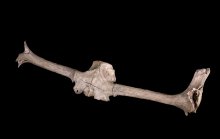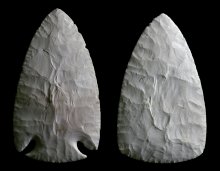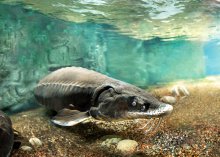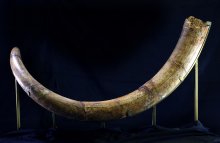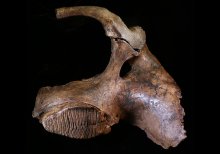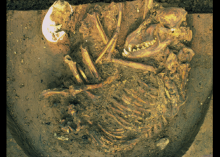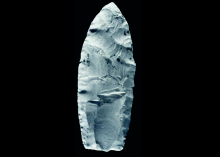The Arrival of Native Nations (11,700-4,000 years ago)
To the best of our knowledge, Native Americans arrived in Illinois about 12,000 years ago. They encountered what remained of soon-to-be extinct megafauna, such as mammoth and mastodon. A warming climate caused migration of new species into Illinois’ plant and animal communities, including many deciduous trees and animals like the white-tailed deer, which remain common today. For thousands of years, Native Americans survived by hunting and gathering natural resources for food and for materials to make clothing, containers, and shelter. Evidence of their camps and communities are found throughout Illinois.
Most important discoveries are found after digging deep into the earth. One never thinks to look up. But that’s what happened when scientists drove by the Biddle Farm in northern Illinois and saw the large main beam of a set of antlers hanging in a garage. It was too big to be a deer or elk, so they stopped to take a look. What they discovered were antlers of an extinct Stag-Moose, an animal that died over 10,000 years ago. The family found the fossil while digging an irrigation pond years before but didn’t immediately recognize its significance. The family from Elburn donated the find to the Illinois State Museum in 1989.
Despite the best efforts of archaeologists, serendipity often plays a role in the most significant finds. In the case of the Mackinaw Cache, a group of boys hauling gravel on a farm near Mackinaw in 1916 uncovered about 40 spectacular “bifaces” on the slope of a hill just a quarter of a mile from the Mackinaw River. A biface is a stone implement that has been worked on both sides.
Though it sounds like a Great Lakes legend, the Lake Sturgeon is a real, if seldom seen, native of Illinois waters. The largest fish species in the Great Lakes, they can grow to nine feet long and 275 pounds, although four feet and 50 pounds is more typical.
Discovered by an excavation crew in 1926 on the bank of the Ohio River near Golconda in Pope County, this Wooly Mammoth (Mammuthus primigenius) specimen didn’t come quietly. Illinois State Museum Director Aljah R. Crook worked with the crew on scene to recover as much of the Mammoth skeleton as possible.
In what might have been the most successful college field trip of all time, Lincoln College freshman Judd McCullum discovered the tusk of a Wooly Mammoth (Mammuthus primigenius) during a biology lab at the college’s Creekside Field Station in 2005. McCullum discovered the 12-foot-long tusk while conducting a freshwater mussel survey. The mammoth may have been one of the last of its kind in the region. Carbon-14 dating determined the animal died about 11,500 years ago, well after the glaciers had retreated from Illinois.
No one knows for sure when wolves and human beings officially began their mutually beneficial partnership, but some of the oldest known domesticated dogs in North America were found at the Koster Site in Greene County. The remains of four dogs were intentionally buried near human burials there about 8,500 years ago.






